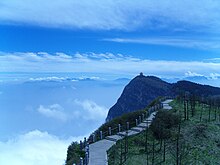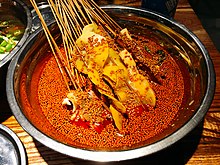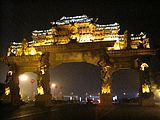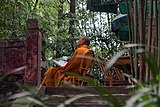Leshan, formerly known as Jiading[a] or Jiazhou, is a prefecture-level city located at the confluence of the Dadu and Min rivers in Sichuan, China. Leshan is located on the southwestern fringe of the Sichuan Basin in southern Sichuan, about 120 km (75 mi) from Chengdu. Leshan is an important industrial city in Sichuan, a regional center city in the south of Chengdu Economic Zone, an important hub city, an important transportation node and a port city in Chengdu-Chongqing. As of the 2020 census, its population was 3,160,168, of whom 1,236,188 lived in the built-up (or metro) area made of Shizhong, Wutongqiao, Shawan and Jinkouhe districts.
Leshan 乐山市 | |
|---|---|
Lizheng Gate Mabian Dafengding National Nature Reserve Wuyou Temple Shizhong Temple | |
 Location of Leshan City jurisdiction in Sichuan | |
| Coordinates (Seat of Leshan municipal government): 29°33′07″N 103°45′58″E / 29.552°N 103.766°E | |
| Country | People's Republic of China |
| Province | Sichuan |
| County-level divisions | 4 Counties, 2 Autonomous Counties, 1 County-level city and 4 Districts |
| Municipal seat | Shizhong District |
| Area | |
| • Prefecture-level city | 12,827.49 km2 (4,952.72 sq mi) |
| • Urban | 1,918.5 km2 (740.7 sq mi) |
| • Metro | 836.1 km2 (322.8 sq mi) |
| Population (2020 census)[1] | |
| • Prefecture-level city | 3,160,168 |
| • Density | 250/km2 (640/sq mi) |
| • Urban | 1,236,188 |
| • Urban density | 640/km2 (1,700/sq mi) |
| • Metro | 1,236,188 |
| • Metro density | 1,500/km2 (3,800/sq mi) |
| GDP[2] | |
| • Prefecture-level city | CN¥ 130.1 billion US$ 20.9 billion |
| • Per capita | CN¥ 39,973 US$ 6,418 |
| Time zone | UTC+8 (China Standard) |
| Postal code | 614000 |
| Area code | 0833 |
| ISO 3166 code | CN-SC-11 |
| Licence Plate Prefixes | 川L |
| Website | leshan |
| Leshan | |||||||||||||||||||||||
|---|---|---|---|---|---|---|---|---|---|---|---|---|---|---|---|---|---|---|---|---|---|---|---|
 "Leshan" in Simplified (top) and Traditional (bottom) Chinese characters | |||||||||||||||||||||||
| Simplified Chinese | 乐山 | ||||||||||||||||||||||
| Traditional Chinese | 樂山 | ||||||||||||||||||||||
| |||||||||||||||||||||||
| Jiading | |||||||||||||||||||||||
| Chinese | 嘉定 | ||||||||||||||||||||||
| |||||||||||||||||||||||
Leshan is a famous historical and cultural city with the reputation of "Begonia Fragrance Country". It is the first open-door city, model green city, excellent tourist city, national garden city and national health city. Leshan has three world-class heritage sites - world natural and cultural heritage Emei Mountain and Leshan Buddha, world irrigation project heritage Dongfengyan and so on.
History
editThe area of present day Leshan was the seat of historical Jiading city,[4] which the historical Jiading city covered not entirely the same area with modern day Leshan city. Some of the area of Leshan county, was ceded to Emeishan city in 1958.[4] In 1978, Leshan as a county-level city was formed.[4] In 1985, the Leshan prefecture-level city was formed, which Emeishan and other county level cities were under the administration of Leshan.[5] Before 1978, Leshan county-level city had Shizhong (means city centre), Wutongqiao (literally 5-"tong"-bridge) and Shawan (literally sand bay) three districts.[5] The establishment of Leshan prefecture-level city, also saw the disestablishment of Leshan Dìqū, an administrative area that supervisee Leshan, as well as other county-level cities and counties.[5]
Xinchang town, Jiading city [sic], was known for late Qing uprising against the government.[6]
Culture
editTourist attractions
edit


In 1996, the Mount Emei Scenic Area, including the Leshan Giant Buddha, the largest stone-carved buddha in the world, which was declared a World Heritage Site by UNESCO. Next door to the Leshan Giant Buddha is the Oriental Buddha Park, a privately run cultural theme park, featuring thousands of reproductions of Buddha statues and Buddhist themed carvings.
Mount Emei is located within the county-level city of Emeishan, which is under the administrative jurisdiction of Leshan.
The ancestral home of Chinese writer, academic and politician Guo Moruo is preserved in the Shawan District of Leshan.[7]
Dialect
editThe Leshan dialect, part of the Southern linguistic system, is very different from the dialects of other cities in the province of Sichuan, which belong to the Northern system. Some researchers say the pronunciation of Leshan dialect represents an archaic form of Chinese pronunciation.
Food
edit
Falling into the Sichuan cuisine family, Leshan is noted for its food culture in that it has all the street food from its surrounding areas, which has made it the one-stop street food city. Typical specialties include:
- Malatang (麻辣烫) - Hot and spicy soup
- Boboji (钵钵鸡)[8] - Bobo chicken
- Shaokao (烧烤) - Street barbecue
- Qianwei Baobing (犍为薄饼) - Qianwei Pancakes
- Doufunao (豆腐脑) - Leshan Style Tofu Soup
- Tianpiya (甜皮鸭) - Sweet-Skinned Duck
- Qiaojiao Niurou (翘脚牛肉) Leshan Style Beef Hotpot
- Xiba Doufu (西坝豆腐) Xiba Tofu[9]
- Mi Liang Gao (米凉糕) - A snack made with rice
Transport
editThere are Chengdu–Mianyang–Leshan intercity railway and Chengdu–Guiyang high-speed railway serving Leshan.
The G0512 Chengdu–Leshan Expressway with a total length of 160 kilometers, was finished on January 14, 2000. This Freeway has since become very important to the city's development.
Education
editLeshan Normal University (乐山师范学院) and Leshan Vocational & Technical College (乐山职业技术学院) are two government-fund colleges in the city.
The Engineering&Technical College of Chengdu University of Technology (成都理工大学工程技术学院) is a non-government college, which was established in 2003.
Administrative divisions
edit| Map | |||||
|---|---|---|---|---|---|
| Name | Hanzi | Hanyu Pinyin | Population (2020 census)[10] | Area (km²) | Density (/km²) |
| Shizhong District | 市中区 | Shìzhōng Qū | 814,597 | 825 | 987 |
| Shawan District | 沙湾区 | Shāwān Qū | 144,931 | 617 | 235 |
| Wutongqiao District | 五通桥区 | Wǔtōngqiáo Qū | 237,933 | 474 | 502 |
| Jinkouhe District | 金口河区 | Jīnkǒuhé Qū | 38,727 | 598 | 65 |
| Emeishan City | 峨眉山市 | Éméishān Shì | 419,107 | 1,168 | 359 |
| Qianwei County | 犍为县 | Qiánwéi Xiàn | 416,673 | 1,375 | 303 |
| Jingyan County | 井研县 | Jǐngyán Xiàn | 280,641 | 841 | 334 |
| Jiajiang County | 夹江县 | Jiājiāng Xiàn | 305,441 | 749 | 408 |
| Muchuan County | 沐川县 | Mùchuān Xiàn | 192,313 | 1,401 | 130 |
| Ebian Yi Autonomous County | 峨边彝族自治县 | Ébiān Yízú Zìzhìxiàn | 121,554 | 2,395 | 51 |
| Mabian Yi Autonomous County | 马边彝族自治县 | Mǎbiān Yízú Zìzhìxiàn | 188,251 | 2,383 | 79 |
Geography and climate
editLeshan City is located in central Sichuan Province, southwest of the Sichuan Basin. Meishan borders on the north, Zigong and Yibin in the east, Liangshan in the south, and Ya'an in the west. Leshan city is located in the transition zone from Sichuan basin to southwest mountainous area, the overall trend is high in southwest, low in northeast, with wide difference in height. Landforms are mountainous, hilly, Pingba three types, mainly mountainous.
Leshan has a monsoon-influenced humid subtropical climate (Köppen Cwa) and is largely mild and humid. Winter is short, mild and dry, with a January average of 7.4 °C (45.3 °F), and while frost may occur, snow is rare. Summers are long, hot and humid, with highs often exceeding 30 °C (86 °F), yet extended heat waves are rare. The daily average in July and August is around 26 °C (79 °F). Rainfall is light in winter and can be heavy in summer, and more than 70% of the annual total occurs from June to September.
The climate in the southwest mountainous area has obvious vertical differences and the climatic conditions are very complex, which is a region for the development of comprehensive agricultural management and three-dimensional agriculture in the region, the main production area of wood, tea, Chinese medicinal materials and other crops, and also a valuable tourism resource. Affected by the monsoon and the uplift of the terrain, the climate is humid and the rainfall is abundant.
| Climate data for Leshan, elevation 424 m (1,391 ft), (1991–2020 normals, extremes 1971–2010) | |||||||||||||
|---|---|---|---|---|---|---|---|---|---|---|---|---|---|
| Month | Jan | Feb | Mar | Apr | May | Jun | Jul | Aug | Sep | Oct | Nov | Dec | Year |
| Record high °C (°F) | 19.3 (66.7) | 23.9 (75.0) | 32.5 (90.5) | 34.7 (94.5) | 36.5 (97.7) | 36.8 (98.2) | 37.6 (99.7) | 39.7 (103.5) | 36.3 (97.3) | 30.1 (86.2) | 25.7 (78.3) | 19.8 (67.6) | 39.7 (103.5) |
| Mean daily maximum °C (°F) | 10.3 (50.5) | 13.3 (55.9) | 18.3 (64.9) | 23.8 (74.8) | 27.3 (81.1) | 29.2 (84.6) | 31.3 (88.3) | 31.0 (87.8) | 26.5 (79.7) | 21.4 (70.5) | 17.0 (62.6) | 11.6 (52.9) | 21.8 (71.1) |
| Daily mean °C (°F) | 7.4 (45.3) | 9.8 (49.6) | 14.0 (57.2) | 18.9 (66.0) | 22.4 (72.3) | 24.6 (76.3) | 26.6 (79.9) | 26.3 (79.3) | 22.6 (72.7) | 18.2 (64.8) | 13.9 (57.0) | 8.9 (48.0) | 17.8 (64.0) |
| Mean daily minimum °C (°F) | 5.3 (41.5) | 7.4 (45.3) | 10.9 (51.6) | 15.3 (59.5) | 18.7 (65.7) | 21.3 (70.3) | 23.3 (73.9) | 23.0 (73.4) | 20.1 (68.2) | 16.1 (61.0) | 11.8 (53.2) | 7.0 (44.6) | 15.0 (59.0) |
| Record low °C (°F) | −1.7 (28.9) | −1.9 (28.6) | 0.2 (32.4) | 4.9 (40.8) | 10.5 (50.9) | 15.3 (59.5) | 17.6 (63.7) | 17.3 (63.1) | 13.6 (56.5) | 5.3 (41.5) | 2.2 (36.0) | −2.9 (26.8) | −2.9 (26.8) |
| Average precipitation mm (inches) | 14.4 (0.57) | 21.9 (0.86) | 42.5 (1.67) | 85.2 (3.35) | 104.8 (4.13) | 146.1 (5.75) | 256.2 (10.09) | 295.8 (11.65) | 132.2 (5.20) | 59.9 (2.36) | 29.6 (1.17) | 13.7 (0.54) | 1,202.3 (47.34) |
| Average precipitation days (≥ 0.1 mm) | 9.7 | 10.2 | 12.9 | 14.3 | 14.5 | 16.4 | 15.5 | 15.0 | 15.9 | 16.4 | 9.6 | 9.1 | 159.5 |
| Average snowy days | 0.6 | 0.3 | 0 | 0 | 0 | 0 | 0 | 0 | 0 | 0 | 0 | 0.2 | 1.1 |
| Average relative humidity (%) | 80 | 77 | 73 | 72 | 71 | 77 | 79 | 79 | 82 | 84 | 81 | 82 | 78 |
| Mean monthly sunshine hours | 38.5 | 51.9 | 89.8 | 119.3 | 121.6 | 104.4 | 132.9 | 145.2 | 71.9 | 49.5 | 52.4 | 37.5 | 1,014.9 |
| Percent possible sunshine | 12 | 16 | 24 | 31 | 29 | 25 | 31 | 36 | 20 | 14 | 17 | 12 | 22 |
| Source 1: China Meteorological Administration[11][12] | |||||||||||||
| Source 2: Weather China[13] | |||||||||||||
Water resources
editLeshan City borders on numerous rivers, with Minjiang River, Dadu River, Qing Yi River and many small and medium-sized rivers, is a water-rich area.
- Water resources: 85.51 billion cubic metres
- Theoretical reserves of hydraulic resources: 7.9 million kilowatts
- Developable capacity: 5.75 million kilowatts
- Main hydropower stations: Gongzui hydropower station (700,000 kW), Tongjiezi hydropower station (600,000 kW)
Mineral deposits
editApproximately 30 proven resources have been identified. The reserves of phosphorus, halite, limestone, kaolin, natural gas, gypsum, dolomite, mineral water and mirabilite are relatively large.
Property
editThe state focuses on protecting rare plants such as silver fir, Davidia involucrata, Metasequoia glyptostroboides, and other rare animals such as giant pandas, Kallima inachus.In 1986, the site of the Song Dynasty kiln was discovered in Xiba Town, Wutongqiao, Leshan City, and the Xiba kiln porcelain used in large quantities by the people surfaced, and the scientific and technological personnel of Sichuan Province conducted a large-scale investigation and found that the Xiba kiln was almost on an equal footing with the contemporaries of Jianyao and Jizhou kilns. The main feature is the kiln transformation that occurs during the firing process, which is beautiful and endless. A Xiba kiln lamp tree with the words "Taihe" was recently discovered, and it is estimated that during the Jin Zhangzong period from 1201 to 1208, Leshan City may have been under the rule of the Jin Dynasty. It was not the Southern Song Dynasty.
Gallery
edit- Leshan
- Night view
- Buddhist temple
- Buddhist Monk in Leshan
- Lingbao Pagoda
Sister cities
edit Hervey Bay, Queensland, Australia
Hervey Bay, Queensland, Australia Gilbert, Arizona, United States
Gilbert, Arizona, United States Ichikawa, Chiba, Japan,[14] established due to Leshan native Guo Moruo residing there for 10 years with his wife, Sato Tomiko.[15]
Ichikawa, Chiba, Japan,[14] established due to Leshan native Guo Moruo residing there for 10 years with his wife, Sato Tomiko.[15] Prachuap Khiri Khan,Thailand
Prachuap Khiri Khan,Thailand Issy-les-Moulineaux,France
Issy-les-Moulineaux,France
Population
editAccording to the sixth national census in 2010, the city's resident population stood at 3235,756,[16] a decrease of 88,383 or 2.66% over the fifth national census. The average annual decrease was 0.27 per cent. Of these, the male population is 1631206, or 50.41 per cent, and the female population is 1604,550, or 49.59 per cent. The sex ratio of the total population (100 females) is 101.66.The population aged 0-14 years is 452,148, or 13.97 per cent; the population aged 15-64 years is 2387,477, or 73.78 per cent; and the population aged 65 and over is 396,131, or 12.24 per cent. The Han Chinese population is 3075,481, accounting for 95.05 percent; the ethnic minorities are 160,275 or 4.95 percent; and the Yi population is 153,092 or 4.73 percent.
In 2017, the city's registered population was 3.518 million, accounting for 3.86 percent of the province's total population; at the end of the year, the resident population was 3.272 million.
Nationality
editThere are 41 ethnic groups in Leshan City. Han, Yi, Hui and Miao live in the world.
Han nationality is the main, followed by Yi nationality, ethnic minorities about 113,000 people, accounting for 3.2 percent of the total population.
Yi Nationality: A major minority nationality concentrated in the south of Ma Bian, Ebian Yi Autonomous County, and Jinkouhe District.
Notable person
editFamous place
edit- Leshan Buddha
- Reclining Buddha
- Mount Emei
- Mahaoya Tomb
- Thousand Buddha Rock in the Jiajiang River
- Ebian Black Bamboo Gou
- Guo Moruo's hometown
- Luocheng Ancient Town
- Wutong Bridge
See also
editNotes
editReferences
editExternal links
edit
 Leshan travel guide from Wikivoyage
Leshan travel guide from Wikivoyage- Official Government Website
















